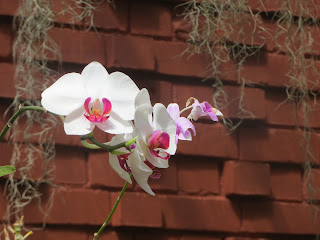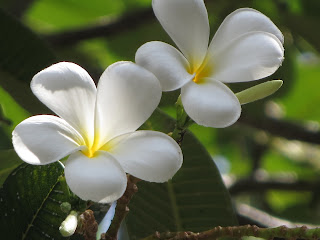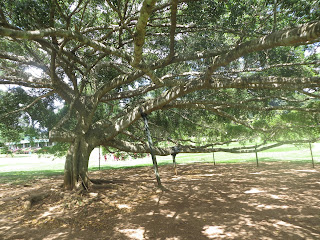Peradeniya Botanic Garden-Orcids
Peradeniya Royal Botanical Gardens, Kandy, Sri Lanka
A walker's paradise
The finest of its kind in AsiaPeradeniya Botanical gardens, the finest of its kind in Asia, the largest of the three botanical gardens in the island, couldn't be better located. In the Mediterranean climate of Kandy, the gateway to the central highlands, the Gardens were bounded on three sides by a loop of river Mahaweli.
The history of the park
Then again, the history of the park wouldn't take a backseat to its geography. Conceived originally in 1371 as the Queen's pleasure garden, it was developed by King Kirti Sri Rajasinhe (1747-1778) where royal visitors were entertained. It was converted into Botanical Gardens in 1821, by the British, six years after fall of the last Kandyan King. That was during enterprising governorship of Sir Edward Barnes, who had Sri Lanka's first tea trees planted here in 1824, though the full commercial potential wasn't to be realized for another half a century. All prime imported crops - Coffee, tea, nutmeg, rubber & cinchona - were tested in these gardens. Imported crops Tea & Rubber together with the local crop of Coconut became mainstay of the economy of the island.
4000 labelled species
A signboard at the entrance, with a map, feature a numbered circuit from 1-30. The corresponding numbers are placed at strategic points on the route, black on a yellow background. 60 ha (150 acres) gardens, where you can easily stroll around a whole day, are stuffed with a bewildering variety of local & foreign tree & plant species. There are around ten thousand plants & trees inclusive of 4000 labelled species. One of the most interesting sites here is bizarre-looking snake creeper, whose tangles area roots look just like a writhing knot of vipers.
The spice garden, Orchid house
The spice garden to the right of entrance is replete with exotic spices. Cardamom, Coves, Pepper & Vanilla. We follow the path to the right, right into the Orchid House with an outstanding collection.
Natural pavilion
Grown from a sapling brought from East Indies, huge Javan fig tree covering 1600 sq. meters of the lawn, with its sprawling roots & branches create a remarkable natural pavilion.
Avenues
The Cabbage Palm Avenue from the South America was planted in 1905. Walking along the stately avenue of Royal Palms (1885) we find fruit bats in large colonies hanging in the trees. Oh! Yes, true to their style, upside down. The River drive goes through a great circle, a large grassy central area around which a remarkably diverse array of dignitaries has planted further specimens.
The Accidental planters
Alongside generations of English royalty, there are trees planted by Indira Gandhi, Yuri Gagarin, Marshal Tito, U Thant & Harold Macmillan. Between the great circle & the great lawn is the Herbarium. Then there is an arboretum.
Lawns, pavilions, sandwiches & a cup of tea
There are extensive well-kept lawns, pavilions, an Octagon Conservatory, fernery, banks of Burmese, Chinese & Japanese bamboos & numerous flower borders with cannas, hibiscus, chrysanthemums, croton & colourful bougainvillaea. You will see unusual exotic species, especially palms (Palmyra, talipot, royal, cabbage) & Ficus elastica (latex-bearing fig or "Indian rubber tree" with buttress roots), an amazing avenue of drunken looking pines & some magnificent old specimens trees. In all, there are about 4000 labelled species.
Cannonball avenue
Cannonball Avenue is lined with beautiful cannonball trees, wreathed in creepers from which hang the large, round fruits. These Sal trees are loved by the Sinhalese. The flowers have a singular shape: a tiny stupa shaped bud in the centre is shaded by a cobra like hood & surrounded by tiny florettes which resemble a crowd of worshipers. It is believed Prince Siddhartha (who was to become Gautama Buddha) was born in a park of Sal trees called Lumbini, near the Sakyan kingdom of Kapilavastu in then north India, now the southern region of Nepal.
Talipot palms
Talipot palms are the easiest to identify with its enormous leaves. The talipot palm is one of Sri Lanka's botanical celebrities, an arboreal oddity which flowers just once in its lifetime, after about forty years, producing the largest cluster of flowers in the world. In Kandyan times the enormous leaves reaching a height of 10 m were used to make tents by sewing a couple of leaves together. "One single Leaf being so broad & large, that it will cover some fifteen or twenty men, & keep them dry when it rains" wrote Robert Knox. Talpot leaves were utilized to produce fine ultra long lasting solid parchments called Ola, in Sri Lanka & India as early as in 500 BC. Young talipot leaves were boiled, dried in the sun, exposed to dew & smoothed & stretched. The treated leaves were then engraved with writing using steel stylus to cut in the characters. Then the engraved leaf was smeared with ink made out of a resin blended with finely powdered charcoal. The great chronicle of Sri Lanka (Mahawamsa) & all other ancient books were written on these treated, cut & loosely bound talipot palm-leaf parchments.
Artificial lake
In the centre of the Gardens is an artificial lake with water plants including the giant water lily & papyrus reeds. Beside the lake is a white-domed rotunda commemorates George Gardener, the Superintendent of the park during 1844-1849. Few Victorian travellers can have been so appropriately named as George Gardener (1812-1849), the botanist. Gardener collected thousands of specimens during his four years of explorations in Brazil & was responsible for importing rubber as well as cinchona. Both of these imports have been blessings to the island; rubber becoming a prime export & bark of cinchona tree producing anti malaria drug quinine.
Coco de Mer
One of the rarest plants in the world, Coco de Mer is on a path leading to this monument of Gardner. This plant has the largest & heaviest fruit or nut in the plant kingdom, weighing an average some10 - 20 kg. They take between five to eight years to mature & are surprisingly productive. It is not unusual to have 20 nuts on a tree. They are all carefully numbered. Native Coco de Mer are only found in Praslin, an island in the Seychelles. Strolling along the path we reach lily tank which is surrounded by giant bamboo, some 40m tall that grows 2-3 cm a day.
Suspension Bridge
Halfway around River Drive is the Suspension Bridge across the River Mahaweli, which takes us to the School of Tropical Agriculture at Gannoruwa, where research is carried out into various important spices & medicinal herbs as well as into tea, coffee, coca, rubber, coconuts & varieties of rice & other cash crops.
Peradeniya campus
Just across the main road from the gardens is Peradeniya campus of Sri Lanka University (1942), built in the old Kandyan style in an impressive setting of a large park with the River Mahweli running through it & the surrounding hillocks




Comments
Post a Comment